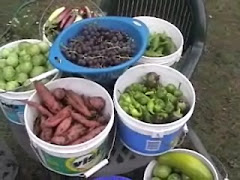
The big difference between Mrs. H and I is that she's a "spur of the moment" kind of gal and I am a "let's take a year to think about it" type of guy. For example, a couple weeks ago she hollered at me from the other room -
"Guess what I found on Craigslist?"
"What?" I shouted back
"Chickens," she called out, walking into the kitchen. "Young ones too, and they're orangish colored."
"Orangish?" I inquired, rolling my eyes. "Hmm, I wonder what breed that could be?"
"It doesn't matter, there's no time because their FREE!" she exclaimed in a slightly elevated tone.
"Why are they free?" was my skeptical counter.
With a slight look of disgust, she replied "Who knows, but if I don't respond right this minute they will be GONE! FREE, did you hear me, they're FREEEEE!!"
And with a deep sigh, I conceded "Yes dear, if it makes you happy we can go look at them" and so she called the phone number, and so we went and looked, and thus it was that we eventually acquired a few new laying hens.
Sometimes it seems that no matter how hard one plans and schemes the Gods of Chaos will prevail. I had it all worked out in my structured little mind and once again she proceeded to challenge my boundaries. The plan was to pick and order new hens from the below listed birds that I had thoroughly researched and decided on. The 6-10 new additions, based on cold hardiness, egg laying abilities, size, temperament, and recommendations from other bloggers who raise chickens in colder climates were to be chosen, if available, out of the following breeds;
AmeraucanaAustralorpBuff OrpingtonChanteclerDelawarePlymouth RockRed StarRhode Island RedsSussexWyandotteCochin Russian Orloff But no! The word "free" is like a drug to my wife and we have now been gifted with many new additions to our motley crew of laying hens. The newest hens supposedly range in age from 6 months to just over a year old and were offered on Craigslist because the owners could no longer care for them and were willing to part with the birds for free under the conditions that we provide a good home and not use their pets as stewing hens...only two of them were "orangish" colored and there were really 7 hens not 6 as the ad suggested.:) And so now we have;
Two small scrappy white
Leghorns that I just adore. I would have never considered this breed but am so happy to have been talked into them as they are the neatest, busy, smartest little birds I ever did see. One of them even laid two eggs the day before yesterday...that was a surprise but apparently possible upon occasion.

A lone Red Star, such a sweet, friendly, very curious little bird, and quite smitten with our dog Rowdy whom she no doubt thinks is a rooster...he is a pretty cocky little fellow after all.

Two Buff Orpingtons, that, like the Red Star, were at least on my original list. They seem to be great birds and immediately honed in on the nest boxes and laid us a couple eggs.

And two more scraggly looking Rhode Island Reds that are as cockeyed crazy as my originals but should be a nice addition to our flock that now numbers 16.

That Mrs. H, she does like her deals and because of it we now have a larger flock that has meshed together without incident allowing us to avoid the challenge of raising baby chicks this spring. Luckily, the new gang of hens has been very submissive to our originals and no serious squabbling has taken place. The new birds are very happy as their old digs left much to be desired. The weather was nice enough the other day that they even ventured outside for a while, their first taste of freedom no doubt. Unfortunately, today's colder weather has somewhat tempered their enthusiasm for the great outdoors.
Oh, and my good wife found this half starved cat in our barn this winter too...it is sitting on my lap begging for attention as I try to type this...Ay yi yi. Meet Nikita Katerina (right), master of her domain and proprietor of the chair pictured below. She was spayed yesterday so everyone is being extra nice to her, even Spooky, our grumpy old orangish colored cat.:)

It's kind of a strange system that Mrs. H has put in place here, and one that always leaves me scratching my head wondering what the heck I just got myself into...and I wouldn't change a thing.:) As they say "
Compromise, if not the spice of life, is its solidity. It is what makes nations great and marriages happy.”































